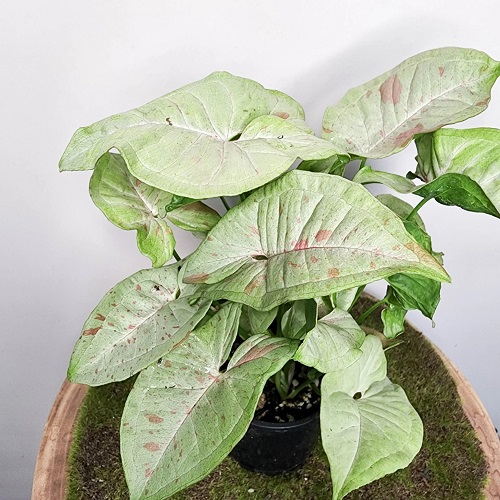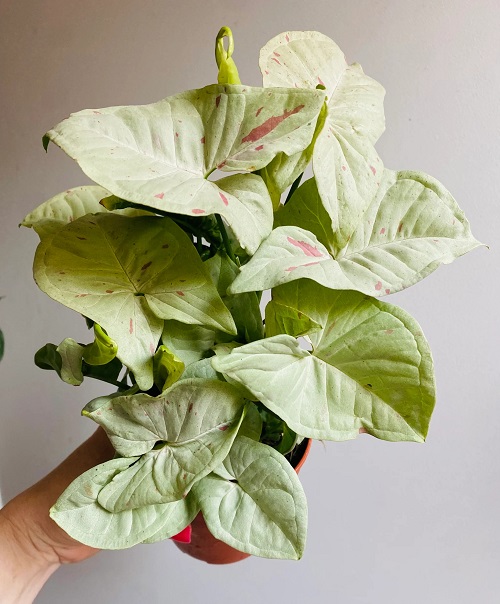Add a touch of tropical charm to your plant collection with the beautiful variegated foliage of Syngonium Confetti!

Native to the tropics of Central and South America, Syngonium confetti is widely loved for its attractive foliage and easy maintenance plant that can add a touch of sophistication to any space. Learn all about growing this attractive houseplant with this comprehensive care guide!
- Botanical Name: Syngonium podophyllum ‘Confetti’
- Popular as—Arrowhead vine, Goosefoot plant, Nephthytis
- Prefers bright, indirect light
- Thrives in a temperature range of 65-80°F or 18-26°C
- Toxic to pets and humans
KNOW EVERYTHING ABOUT GROWING SYNGONIUM PINK ALLUSION INDOORS HERE
What is Syngonium Confetti?

Hailing from the Araceae family, Syngonium confetti is a tropical aroid featuring large arrowhead-shaped leaves. The pale green foliage stands out with speckled pink variegation that looks like blood clots against the dull background. Young leaves often appear more heart-shaped, while mature leaves display the characteristic arrowhead shape, with lobes extending outwards from the central leaf vein.
With a compact growth habit and low care needs, the plant can beautifully sit in small pots making for an attractive tabletop or work desk addition.
Syngonium Confetti vs Milk Confetti
Both the Syngonium cultivars share a close resemblance to each other with a few exceptions:
- Appearance: Syngonium confetti features arrowhead-shaped leaves, whereas Milk Confetti has more rounded leaves. Furthermore, the former has smaller leaves in comparison to Milk Confetti.
- Foliage Color: The leaves of Syngonium confetti exhibit a speckled pattern, while Milk Confetti’s leaves have distinct white splotches.
- Growth Habit: Syngonium confetti tends to grow in a more upright fashion, while its competitor has a trailing or vining growth habit.
Ideal Pot Size
Get a pot that is one inch bigger than the plant’s root balls; ideally, a 4-6 inches pot will be good enough for a young Syngonium Confetti. This will allow the roots to spread and grow without becoming overcrowded. As the plant grows, you might need to repot it to a one-size bigger container, which may take 2-3 years. Ensure to drill enough holes to drain out excess water from the base.
Syngonium Confetti Propagation

Syngonium confetti can be propagated easily through stem cuttings in these easy steps. Get a healthy, disease-free mother plant, a sterile clipper, a pot with drainage holes, and some well-draining potting mix to proceed:
- Choose a healthy stem with at least two or three leaves and make a cut just below a leaf node using sterile clippers.
- Remove the lower leaves from the stem, leaving only one or two leaves at the top.
- Dip the cut end of the stem into rooting hormone powder to encourage root growth.
- Plant the stem cutting into a small pot filled with moist potting soil.
- Cover the pot with a plastic bag or clear plastic wrap to create a humid environment.
Place the pot in a bright, indirect light and keep the soil moist. In about 4-6 weeks, the stem cutting will be rooted and should be provided with a favorable growing environment.
Syngonium Confetti Care

Light
Your Syngonium Confetti will be happiest in bright, indirect light. Too much direct sun can harm its leaves and dull their stunning colors, so keep the plant away from the intense afternoon sun. Find a spot near a north or east-facing window with diffused light.
You can also use fluorescent or LED grow lights for a little extra boost if your home receives very little natural light.
Soil
For Syngonium Confetti, well-draining soil with plenty of organic matter is key. A blend of peat moss, perlite, and vermiculite will keep your plant comfortable. Steer clear of dense or compacted soil, as it can hold too much water and lead to root rot.
Water
While Syngonium Confetti enjoys moist soil, it’s not a fan of soggy conditions. Water it when the top inch of soil feels dry, and use room-temperature water to prevent any shock to the roots. You may also follow a weekly deep-watering session, i.e., saturate the medium allowing excess water to drain away. Repeat the process when the top inch dries out.
In winter, when growth slows, you can cut back on watering a bit.
Temperature & Humidity
This plant loves temperatures ranging from 65-80°F (18-26°C). Keep it away from temperatures below 50°F (10°C), as colder conditions can cause harm. Syngonium Confetti also appreciates humidity levels of at least 50%. You can raise humidity by misting the plant, placing it on a tray with pebbles and water, or using a humidifier.
Fertilizer
During spring and summer, Syngonium Confetti appreciates regular feedings. Apply a balanced liquid fertilizer at half strength every 4-6 weeks. As winter rolls around and growth slows, you can reduce or even stop fertilizing.
Pruning
To keep your Syngonium Confetti looking tidy and well-shaped, give it the occasional prune. Use clean pruning shears to remove any dead, damaged, or yellowing leaves. Pinch back the stem tips for a bushier look, and if the plant starts to get too leggy, trim the stems to encourage fresh growth.
Major Troubleshooting Tips
Syngonium confetti is a relatively low-maintenance plant, but it can still experience some common issues. Here are some major troubleshooting tips to help address them:
- Wilted or Yellow Leaves: Wilted or yellow leaves can be a sign of overwatering, underwatering, or exposure to direct sunlight. Check the soil moisture level and adjust your watering schedule accordingly. Also, make sure the plant is not getting too much direct sunlight, and move it to a spot with brighter, indirect light. If the plant is still struggling, you may need to repot it into fresh soil to improve drainage.
- Curling or Crispy Leaves: Majorly a sign of low humidity, too much direct sunlight, or pest infestations. Increase the humidity around the plant by misting it regularly or placing it on a tray of pebbles and water. Move the plant to a spot with brighter, indirect light, or filter the light with a sheer curtain.
- Leggy or Sparse Growth: Leggy or sparse growth can be a sign of low light or lack of nutrients. Move the plant to a spot with brighter, indirect light, or consider supplementing the light with fluorescent or LED grow lights. Fertilize the plant regularly with a balanced liquid fertilizer to provide it with the necessary nutrients for healthy growth. You can also prune the plant to encourage bushier growth.
- Pests: Syngonium Confetti can be susceptible to common houseplant pests such as spider mites, mealybugs, and scale insects. Inspect the plant regularly for any signs of pests, such as webbing, sticky residue, or tiny crawling insects. Treat the plant with insecticidal soap or neem oil spray to keep them at bay.
Where to Buy Syngonium Confetti?
Syngonium confetti can be found at many local nurseries and garden centers that specialize in houseplants. You can also find the plant online through websites like Etsy, eBay, and Facebook Marketplace, where individual sellers might offer Syngonium Confetti for Sale. When buying online, be sure to read the seller’s reviews and ratings to ensure that you are buying from a reputable source. You can also ask the seller for photos of the actual plant that you will be receiving to ensure that it is healthy and in good condition.






